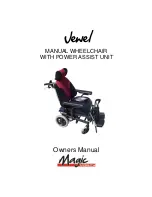
TiLite
®
OM000007 - Rev. B
1
CHAPTER 1: WARNINGS
CHAPTER 1: WARNINGS
CHAPTER 1: WARNINGS
CHAPTER 1: WARNINGS
CHAPTER 1: WARNINGS
GENERAL WARNINGS
A. SAFETY INSPECTIONS AND MAINTENANCE
WARNING
It is important to keep your wheelchair in proper working condition. Chapter 2 of this Manual
outlines the safety inspections that you should make before each use of your chair as well as
weekly, quarterly and annual inspections.
1. ALWAYS inspect and maintain your TiLite wheelchair strictly in accordance with the instructions
and charts in Chapter 2.
2. If you detect a problem in the course of your inspections or maintenance, ALWAYS have the
chair serviced or repaired to correct the problem BEFORE using the chair.
3. ALWAYS have your chair completely inspected and serviced by an authorized TiLite supplier at
least once a year.
4. ALWAYS perform your safety inspections and any maintenance or adjustments while the chair is
unoccupied.
If you fail to inspect or maintain your wheelchair as directed in this Manual, you may fall, tip over
or lose control of the wheelchair and seriously injure yourself or others or damage the
wheelchair.
B. ACCLIMATING TO YOUR NEW CHAIR
WARNING
Each wheelchair is a unique piece of medical equipment, with unique handling, maneuvering and
ride characteristics. Whether you are a new wheelchair user or have years of experience, you
MUST take the time to acclimate to this particular chair before you begin riding. Start slowly and
take the time to learn the handling, maneuvering and ride characteristics of this chair. For
example, your previous chair may have been a heavier and less responsive chair, and, therefore,
you may be used to using more force than is necessary to maneuver your TiLite chair. If you use
too much force, you may fall, tip over or lose control of the wheelchair and seriously injure
yourself or others or damage the wheelchair.
C. WEIGHT LIMITATION
WARNING
TiLite wheelchairs have a weight limit of 250 pounds (113.6 kilograms). This weight limitation
applies to the combined weight of the user and any items carried by the user. DO NOT exceed
this weight limit. If you exceed the limit, you may fall, tip over or lose control of the wheelchair
and seriously injure yourself or others or damage the wheelchair.
D. PREVENTING ACCIDENTS AND INJURIES
WARNING
1. You MUST be properly and fully trained in the safe use of this wheelchair by your health care
advisor BEFORE you use this chair.
2. Together with your health care advisor, you MUST analyze your level of function and ability and
develop your own methods for safe use that best suit you based on your level of function and
ability.
3. You MUST learn the limits of your ability and operate this wheelchair within such limits. This
means you must PRACTICE the maneuvers you will need to perform, such as bending, reaching
and transfers, until you know the limits of your ability. ALWAYS practice with the assistance of
someone who can help you until you know what can cause, and how to avoid, a fall or tip-over.
NEVER try a new maneuver on your own until you are sure you can do it safely.
4. ALWAYS learn as much as you can about the places where you will be using your chair before
you get there. ALWAYS be alert for hazards and learn how to avoid them.
Summary of Contents for Rigid Aero Z Series
Page 102: ......










































